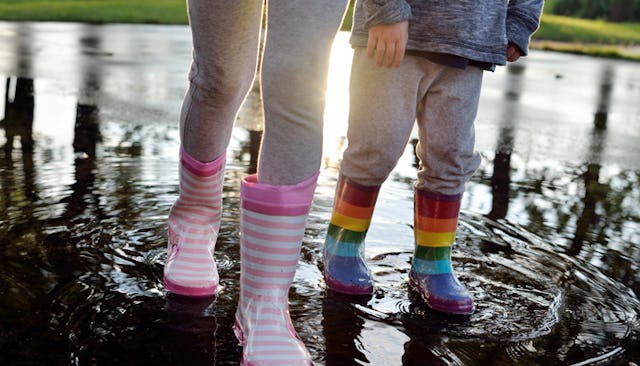Girl Power

My daughters are very different.
My six-year-old is a wisp of a thing. She is a skinny sprite of a girl, all frizzy hair, knobby knees, and ridiculously twiggy limbs, but she has a strength that belies her size. She is lit from within, full of a fiery force that buoys her even though she looks like the slightest breeze could knock her down.
My three-year-old is a deliciously chubby girl. She is almost as tall as her big sister, but she has a baby-like sensitivity that belies her size. She has the face of an infant (and the emotional maturity of one as well). She cries as quickly as she laughs; she crumbles into a soft, sad heap on the floor if you so much as frown at her.
My six-year-old is blonde with icy blue eyes; my three-year-old, like me, has brown hair and dark, dark brown eyes. My six-year-old looks like my husband; my three-year-old looks like me. (In her kinder moments, my mother-in-law likes to helpfully point out that my older daughter inherited her petite frame and that my younger daughter, with all her pudgy parts, clearly takes after me. She’s a real treasure, my MIL.) People often look at my girls questioningly, wondering if they’re sisters. Only once has someone been bold enough to ask me if my daughters have the same parents. (I was too stunned to say anything except “yes”. A good friend suggested that the next time I experience such brazen behavior, I respond with, “as far as my husband knows (wink)”.)
My daughters are a study in both physical and emotional contrasts. They share only one common interest, and it’s an interest I have struggled to accept. Princesses. Princess movies. Princess dolls. Princess clothes.
I attended an all girls’ school from sixth through twelfth grade. My parents sacrificed a great deal to send me there and I am forever grateful to them for the opportunity. It was a lovely place, full of tradition and rigor and, for good measure, a few ivy-covered brick buildings. All the teachers were exceptional – dedicated, brilliant, and creative.
My female teachers served as role models to us all. One particularly memorable English teacher used literature to illustrate how women are so often marginalized, regardless of time or place. She railed against all things “princess”; to her, our society did no greater disservice to young girls than introducing them to princesses in movies, books, and toys. “What are we teaching our future women?”, she would ask, frowning. “That the best they can hope for is a pretty dress, glossy hair, and a man? We are better than that, ladies!!”.
Fast forward twenty years, and here I sit with my daughters, surrounded by princess detritus. I have made sure that my girls have plenty of other toys; their train table is laden with plastic dinosaurs, matchbox cars, and legos. And while they like those things, they always return to the princesses. I could just not give them princess toys, I suppose. However, I am a firm believer that things forbidden are that much more alluring. (Books, however, are a different matter. My daughters are exposed to a huge variety of books and rarely ask for a Disney Princess book. Thank God.)
When my daughters choose a princess toy instead of a more Gloria Steinem-approved item, I hear the voice of my high school English teacher, clear as day. “What are we teaching our future women?!?” I feel riddled with guilt and am certain that I am disappointing all the women who fought so admirably for my civil rights. How will my daughters become strong and independent? How will they learn about girl power? I encourage my daughters to try things that scare them. I show them that women can solve problems on their own. (Because their father’s work often keeps him away until after they are asleep, they know that if something needs to be done, mom does it.) I do my best to teach them that they can be loving and strong. But is this all enough?
About a month ago at the park, my daughters were playing in the sandbox. My three year-old was intensely digging when an older, much larger boy walked over to her and took her shovel. No asking, no communication whatsoever. My child immediately burst into tears. The boy walked away, shovel still in hand. My six-year-old, looking like the world’s smallest pixie, stood up and walked over to the boy. I held my breath and willed myself not to intervene just yet. Don’t whine, don’t beg, and don’t cry, I instructed her in my mind. But don’t yell, don’t shove, and don’t hit, either. My older girl stood by the boy and looked up at him with the iciest glare I have ever seen. She locked eyes with him and, even though I never expected this to happen in real life, he handed her the shovel. The best part? She said “thank you” politely to him. She was strong, cool, and classy under pressure.
My older daughter gave the shovel back to my three-year-old and they continued to play happily. They dug in the sand, getting dirtier with each dig. The dirt would have made my English teacher happy. But the girl power my daughter showed when she defended her little sister would have made her proud.
Go on and play with your princesses, girls, if that’s what you want that day. If you can show strength when it matters, when it’s hard, then you’re going to be just fine.
This article was originally published on